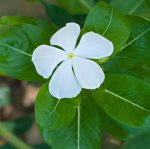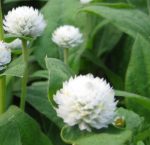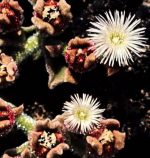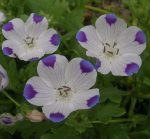
Water is essential for plant growth but plants vary greatly in their need for it. Since the amount of water on earth is finite but the demand is not, we must find more efficient ways to use water and one way to curb water consumption is to employ drought tolerant plants. Here are 5 white flowered annuals or plants grown as annuals that are considered very or extremely drought tolerant because they can live in areas that receive very little rainfall during the growing season. Adjustments may have to be made, however, for summer temperatures, humidity, and rainfall distribution, depending on your local conditions. Photo Credit Wikipedia
Madagascar Periwinkle (Catharanthus roseus aka Vinca rosea) ‘Albus’

This tender perennial, usually grown as an annual, is native to Madagascar where it grows on sand and limestone soils in woodlands, forests, grasslands and disturbed areas. When grown in frost-free areas as a perennial it is shrubby but maintains a herbaceous nature when grown as an annual in cold areas. Plants grow up to 3′ tall and have slender branched stems that carry shiny, oval green leaves up to 2″ long and with a white center vein. From mid spring to early autumn one or more white tubular flowers appear on the stem tips. They are 1.5″ wide and have 5 petal-like lobes. Plants may self-seed. Drought, heat, and humidity resistant, Madagascar periwinkle is an excellent choice as a bedding plant for borders in formal or informal settings, for xeriscapes and containers, and even for houseplant.
Type: Tender perennial grown as annual
Height: 1-3′
Bloom Time: Mid-spring to frost
Light: Full sun with afternoon shade in hot climates
Hardiness: Zones 10-11
Photo Credit:Wikipedia
Snow-in-Summer (Cerastrium tomentosa)

Native to southern Italy, this short-lived perennial is a member of the carnation family, Caryophyllaceae, that also includes pinks, baby’s breath, and chickweed. The spreading plants form mats of densely hairy, silvery-grey stems and leaves up to 6″ tall. The leaves are lanceolate, up to 1″ long, and evergreen. In early summer, clusters of up to 15 white flowers appear on wiry stems 8-12″ tall. The star-like flowers are up to 1″ across and have 5 deeply notched petals. Snow-in-summer is drought resistant but does best in areas with cool dry summers. It spreads by self-seeding and underground runners and can become invasive but is useful as a groundcover, edging, and xeriscape, as well as in rock, wall, and cottage gardens.
Type: Sort-lived perennial
Height: 6-12″
Bloom Time: Early summer
Light: Full sun with afternoon shade in hot climates
Hardiness: Zones 3-7
Photo Credit:Wikimedia Commons
Globe Amaranth (Gomphrena globosa)

Native to Texas and Mexico, this annual grows 1-3′ tall, depending on the cultivar, and has stiff branching stems and lanceolate leaves that are 3-4″ long, slightly hairy, and almost sessile. The globose flowerheads are up to 1.5″ across and consists of colorful papery petal-like bracts and relatively few tiny yellow flowers. The bracts may be white, lavender, pink, red or magenta. Plants flower all summer long and each flowerhead has a long bloom time. The flowerheads are good in fresh or dried arrangements.
Type: Annual
Height: 1-3′
Bloom Time: Summer into fall
Light: Full sun
Hardiness: Not hardy
Crystalline Ice Plant (Mesembryanthemum crystallinum)

This evergreen prostrate annual or biennial is native to southern Africa, Sinai, Canary Islands, and southern Europe where it grows on cliffs, coastal bluffs, sand dunes and disturbed areas. It is a member of the fig-marigold family, Aizoaceae, that also includes New Zealand spinach and “living stones” but is not closely related to either figs or marigolds. Plants grow up to 8″ tall and have 4″ long oval fleshy leaves that are green or red, have wavy margins, and are covered globular bladder cells that reserve water and glisten like ice in the sun. From spring to early summer, white to pale pink flowers appear. They are 3/4-1 1/4″ across, have thin narrow petals, and resemble sea anemones. The flowers open during the day and close at night. Crystalline ice plant accumulates salt in the soil that inhibits the growth of native plants and is considered invasive in parts of California. With proper care, however, it can be successfully used as a groundcover, and in container, rock or seaside gardens.
Type: Annual or tender biennial
Height: 8″
Bloom Time: Spring to early summer
Light: Full sun, tolerates some shade
Hardiness: Zones 8-11
Photo Credit: Wikipedia
Five Spot (Nemophila maculata)

Also known as five-spot baby or buffalo eyes, this trailing annual is endemic to California where it grows primarily in the meadows and woodlands of the Sierra foothills. It is a member of the borge family, Boraginaceae, that also includes forget-me-not, Siberian bugloss, and lungwort. The hairy, bushy plants grow 4-10″ tall and have pinnately lobed leaves that are up to 1″ long. From spring to mid summer, terminal bell-shaped flowers appear. They are up to 2″ in diameter and have five white petals, each with bluish to purple veins and a spot at the tip. The spots attract their primary pollinators, solitary bees. The fruits contain 12 greenish brown seeds and plants reseed readily. Five spot does best in cool weather with sun in the morning but shade in the afternoon. It is a good choice for a groundcover especially over bulbs, as well as for cottage, wildflower, wildlife or meadow gardens.
Type: Annual
Height: 4-10″
Bloom Time: Spring to mid-summer
Light: Full sun with afternoon shade
Hardiness: Not hardy
Photo Credit: Wikimedia